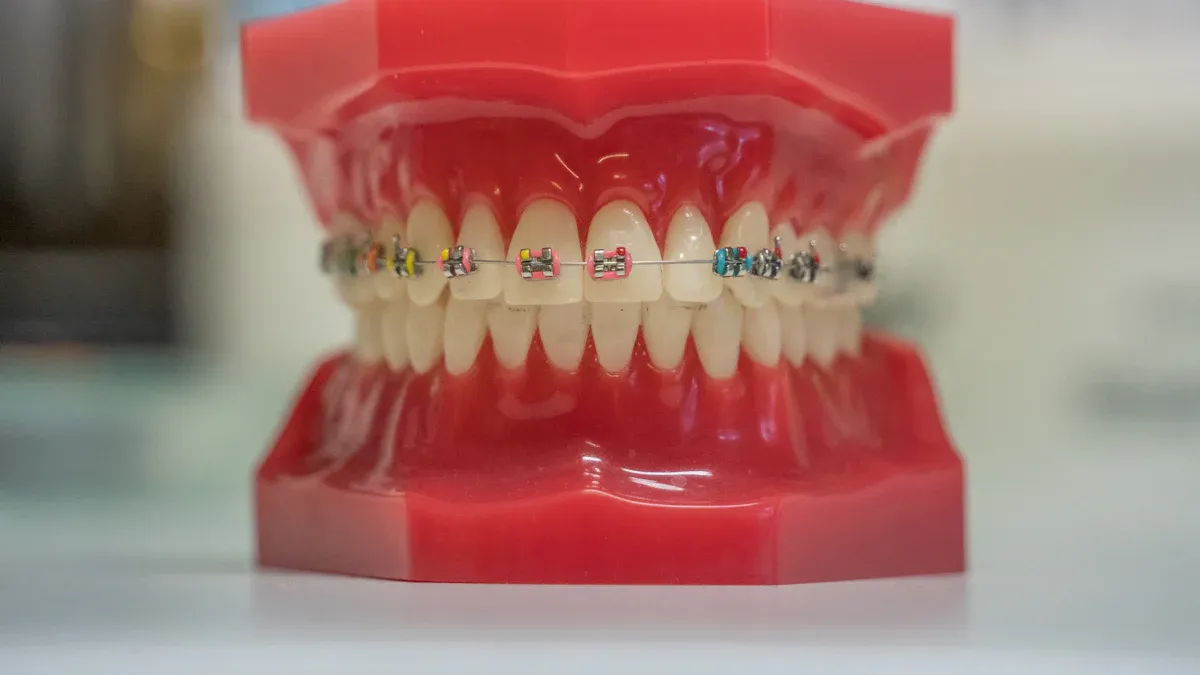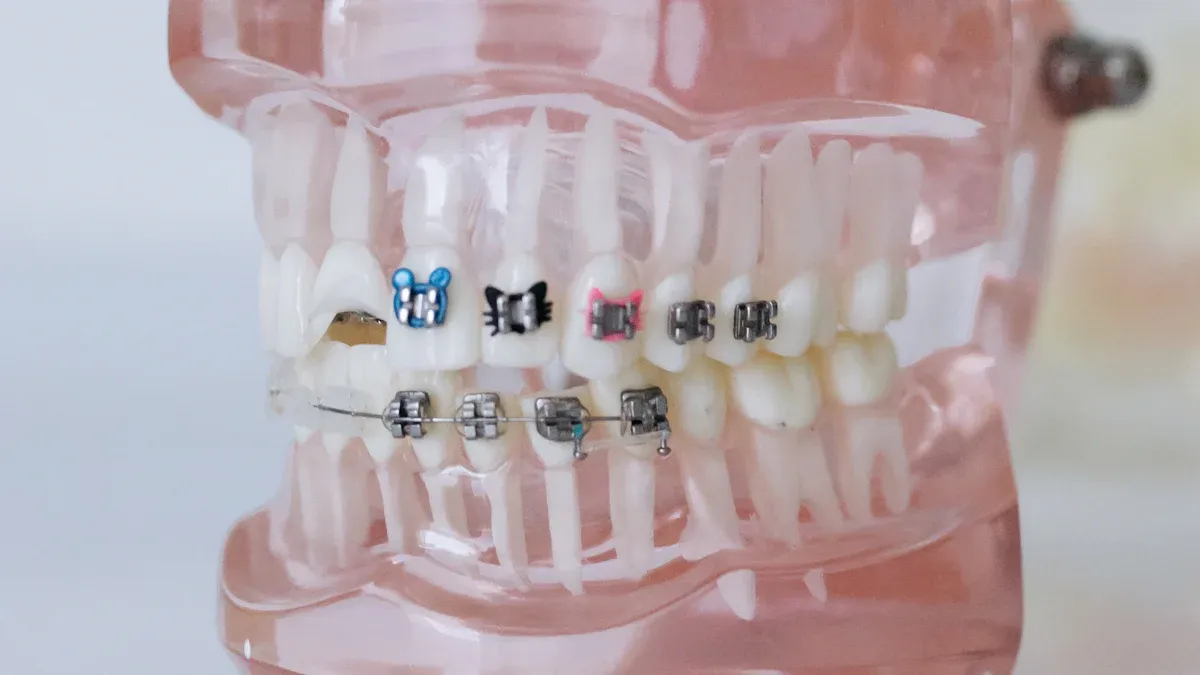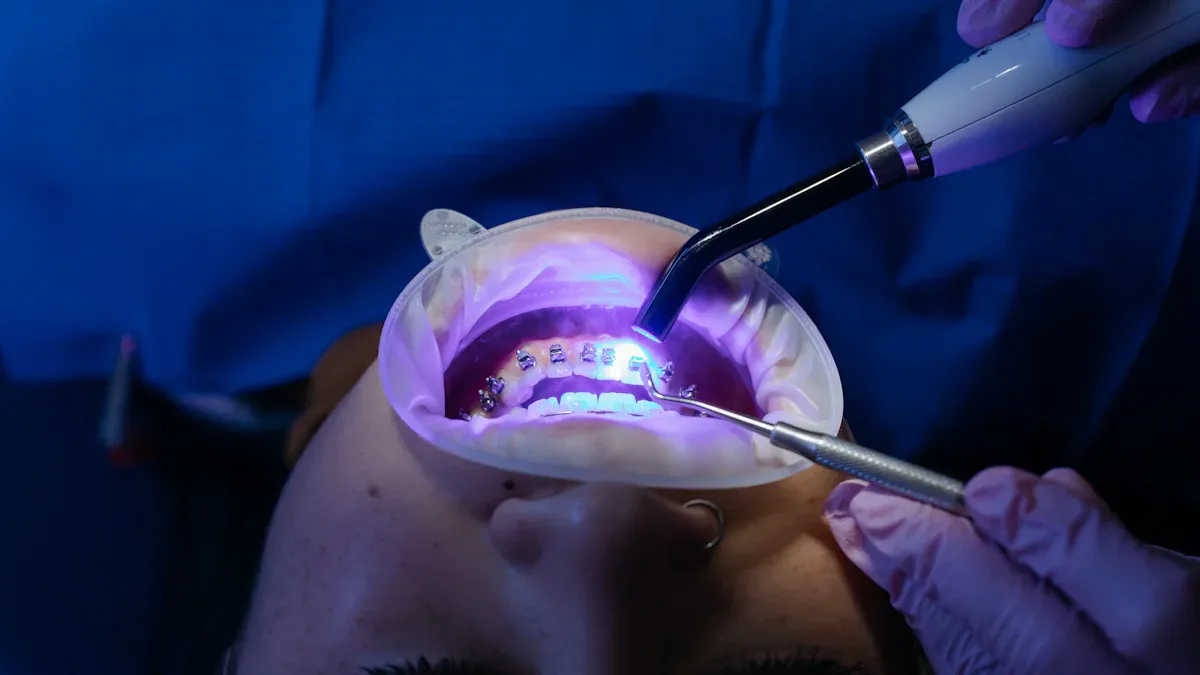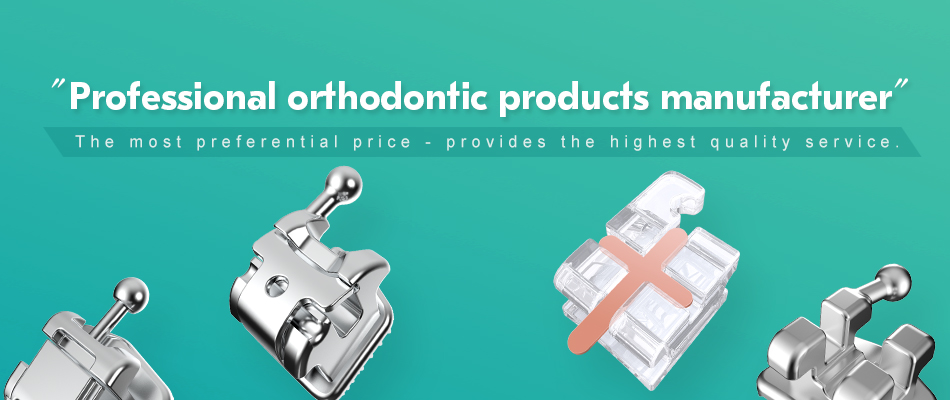
Self-ligating orthodontic brackets have seen major advancements. The top 10 innovations include passive and active self-ligation systems, miniaturized bracket profiles, advanced materials, integrated archwire slot technology, smart features, improved hygiene, customization, better debonding methods, eco-friendly solutions, and leadership from Denrotary Medical Apparatus Co. These breakthroughs help orthodontists achieve faster, more comfortable treatments. Patients experience less discomfort and improved results.
Key Takeaways
- Self-ligating brackets use built-in clips to hold wires, reducing friction and speeding up tooth movement.
- Advanced materials like stainless steel, titanium, and ceramics improve bracket strength, comfort, and safety.
- Miniaturized, low-profile brackets increase comfort and look less noticeable on teeth.
- Smart features such as color-changing indicators and digital tracking help monitor treatment progress easily.
- Open-architecture designs and antimicrobial materials make cleaning easier and improve oral health during treatment.
- Customization options like 3D printing and modular parts allow a better fit and more personalized care.
- Easy-release and reusable brackets reduce treatment time, protect tooth enamel, and support sustainability.
- Eco-friendly innovations use biodegradable materials and energy-efficient production to protect the environment.
Passive Self-Ligation Mechanisms
Passive self-ligation mechanisms have changed the way orthodontists move teeth. These systems use unique designs and materials to improve treatment outcomes. They offer several advantages over traditional brackets.
Clip and Slide Designs
Self-ligating brackets with clip and slide designs use a small door or clip to hold the archwire. This design removes the need for elastic or metal ties.
Reduced Friction
Reduced friction stands as one of the main benefits of passive self-ligation. The clip or slide holds the archwire gently. This allows the wire to move more freely inside the bracket slot. Less friction means teeth can shift with less resistance.
Tip: Lower friction can lead to shorter treatment times and fewer office visits for patients.
Orthodontists notice that wires glide smoothly. This smooth movement helps them apply lighter forces. Patients often report less discomfort during adjustments. The risk of wire binding or notching also decreases.
Enhanced Tooth Movement
Clip and slide designs support more efficient tooth movement. The archwire can guide teeth into position with greater accuracy. Orthodontists can plan treatments that move teeth in a controlled way.
- Teeth respond better to gentle, continuous forces.
- The system reduces the need for frequent wire changes.
- Patients see steady progress throughout their treatment.
These features help orthodontists achieve predictable results. Patients benefit from a more comfortable experience.
Material Improvements
Modern self-ligating brackets use advanced materials. These materials improve the performance and safety of the brackets.
Durability and Strength
Manufacturers use high-grade stainless steel or special alloys for passive self-ligating brackets. These materials resist bending and breaking. Brackets stay strong even under the pressure of tooth movement.
| Material Type | Key Benefit |
|---|---|
| Stainless Steel | High strength |
| Titanium Alloys | Lightweight, strong |
| Ceramic | Aesthetic, durable |
Strong materials mean fewer bracket failures. Orthodontists spend less time on repairs. Patients enjoy a smoother treatment process.
Biocompatibility
Biocompatibility ensures that bracket materials do not harm the mouth. Manufacturers test materials to make sure they are safe for long-term use. Stainless steel and ceramics rarely cause allergic reactions.
Patients with sensitive gums or allergies benefit from these improvements. Orthodontists can treat a wider range of patients safely. The focus on biocompatibility also supports better oral health during treatment.
Note: Choosing brackets with proven biocompatibility can reduce the risk of irritation or infection.
Passive self-ligation mechanisms continue to set new standards in orthodontic care. Their design and material innovations help both orthodontists and patients achieve better results with greater comfort.
Active Self-Ligation Systems
Active self-ligation systems have transformed orthodontic care by introducing dynamic components that interact with the archwire. These systems use mechanisms that apply gentle, continuous pressure to teeth, which can lead to more precise and efficient tooth movement.
Spring-Loaded Clips
Spring-loaded clips represent a major advancement in self-ligating bracket technology. These clips use small, built-in springs to hold the archwire in place. The springs create a constant, gentle force that helps guide teeth into their correct positions.
Controlled Force Application
Spring-loaded clips deliver a steady force to each tooth. This force remains consistent throughout the treatment process. Orthodontists can rely on these clips to maintain the right amount of pressure, which helps teeth move at a safe and predictable rate.
Note: Consistent force reduces the risk of root damage and discomfort for patients.
A table below highlights the benefits of controlled force application:
| Feature | Benefit |
|---|---|
| Steady Pressure | Safer tooth movement |
| Less Force Variation | Reduced discomfort |
| Predictable Outcomes | Improved treatment planning |
Orthodontists see fewer complications when using spring-loaded clips. Patients often report less pain after adjustments. The steady force also helps shorten overall treatment time.
Improved Treatment Precision
Spring-loaded clips allow orthodontists to fine-tune tooth movement. The precise control over force means that each tooth can move exactly as planned. This level of accuracy leads to better alignment and improved bite correction.
- Teeth follow the treatment plan more closely.
- Orthodontists can make small adjustments with confidence.
- Patients achieve better results in less time.
Adjustable Tension Features
Adjustable tension features give orthodontists even more control over the treatment process. These features let them change the amount of force applied to each tooth, based on the patient’s needs.
Customizable Force Levels
With adjustable tension, orthodontists can set different force levels for different teeth. This customization helps address unique dental challenges, such as stubborn teeth or complex alignment issues.
Tip: Customizable force levels can improve comfort and speed up treatment for many patients.
Orthodontists use special tools to adjust the tension in the brackets. This flexibility supports a more personalized approach to care.
Patient-Specific Adjustments
Every patient has a unique smile. Adjustable tension features allow orthodontists to tailor treatment for each individual. They can respond quickly to changes in tooth movement or address unexpected issues during treatment.
- Orthodontists adapt the system as teeth shift.
- Patients receive care that matches their specific needs.
- The risk of overcorrection or undercorrection decreases.
Active self-ligation systems, with their spring-loaded clips and adjustable tension features, offer a new level of control and comfort in orthodontic treatment. These innovations help orthodontists deliver better results while making the process easier for patients.
Miniaturized Bracket Profiles

Modern orthodontics values both function and appearance. Miniaturized bracket profiles represent a significant step forward in self-ligating bracket design. These smaller brackets offer clear advantages for patients and orthodontists.
Low-Profile Designs
Increased Comfort
Low-profile brackets sit closer to the tooth surface. This design reduces the amount of metal or ceramic that touches the inside of the lips and cheeks. Patients often notice less irritation and fewer mouth sores during treatment.
Tip: Smaller brackets help patients speak and eat more comfortably.
Orthodontists report that children and adults adapt faster to low-profile brackets. The reduced size means less bulk in the mouth. Patients can brush and floss with greater ease. Many people feel more confident wearing braces when they experience less discomfort.
Improved Aesthetics
A smaller bracket profile improves the look of orthodontic appliances. These brackets appear less noticeable on the teeth. Many manufacturers offer translucent or tooth-colored options for even greater discretion.
| Bracket Type | Visibility Level | Patient Preference |
|---|---|---|
| Traditional | High | Low |
| Low-Profile Metal | Medium | Medium |
| Low-Profile Ceramic | Low | High |
Patients who worry about the appearance of braces often choose low-profile designs. Orthodontists see higher satisfaction rates among these patients. The brackets blend in with natural teeth, making them ideal for teens and adults who want a subtle look.
Enhanced Bonding Surfaces
Better Adhesion
Miniaturized brackets now feature advanced bonding surfaces. These surfaces use micro-etching or mesh patterns to increase the contact area with dental adhesive. Stronger adhesion keeps brackets firmly attached to the teeth throughout treatment.
Orthodontists value reliable bonding because it reduces the need for emergency repairs.
Patients benefit from fewer interruptions in their treatment. Brackets that stay in place help maintain steady progress toward a healthy smile.
Reduced Debonding Risk
Enhanced bonding surfaces also lower the risk of brackets coming loose. The improved grip between bracket and tooth means less chance of accidental debonding during eating or brushing.
- Fewer broken brackets mean fewer extra visits to the orthodontist.
- Treatment stays on schedule with minimal setbacks.
- Patients experience less frustration and inconvenience.
Orthodontists trust these innovations to deliver consistent results. Miniaturized bracket profiles, with their low-profile designs and enhanced bonding surfaces, set a new standard for comfort, aesthetics, and reliability in orthodontic care.
Advanced Materials and Coatings
Ceramic and Polycrystalline Options
Aesthetic Appeal
Ceramic and polycrystalline brackets have changed the look of orthodontic treatment. These materials blend with natural tooth color. Patients who want a less noticeable option often choose ceramic brackets. Polycrystalline ceramics offer even more translucency. This feature helps the brackets match a wide range of tooth shades.
Patients feel more confident when their braces are less visible. Many adults and teens prefer ceramic brackets for this reason.
Orthodontists see that ceramic brackets do not stain easily. The smooth surface resists discoloration from foods and drinks. This quality keeps the brackets looking clean throughout treatment.
Strength and Durability
Ceramic and polycrystalline brackets provide strong support for tooth movement. Manufacturers use advanced processes to make these materials tough. The brackets resist breaking under normal forces. Polycrystalline ceramics add extra durability because of their unique crystal structure.
A comparison table shows the key benefits:
| Material | Aesthetic Appeal | Strength | Durability |
|---|---|---|---|
| Stainless Steel | Low | High | High |
| Ceramic | High | Medium | Medium |
| Polycrystalline Ceramic | Very High | High | High |
Orthodontists trust these materials for both front and back teeth. Patients enjoy a balance of beauty and function. The brackets stay secure and effective during the entire treatment.
Anti-Friction Coatings
Smoother Wire Movement
Anti-friction coatings represent a major step forward in bracket technology. These special coatings cover the inside of the bracket slot. The archwire slides more easily because of the smooth surface. This design reduces the amount of force needed to move teeth.
- Orthodontists notice less wear on wires.
- Patients experience fewer adjustments and less discomfort.
Tip: Smoother wire movement can help teeth shift more gently, making the process easier for sensitive patients.
Reduced Treatment Time
Anti-friction coatings help speed up orthodontic treatment. The wire moves with less resistance. Teeth respond faster to the gentle forces applied by the brackets. Orthodontists can often use lighter wires for longer periods.
Patients benefit from shorter treatment times. Fewer office visits become necessary. The risk of complications, such as wire notching or bracket failure, decreases.
Integrated Archwire Slot Technology
Modern self-ligating brackets rely on advanced archwire slot technology. This innovation improves how brackets interact with archwires. Orthodontists see better results and patients enjoy smoother treatments.
Precision Slot Manufacturing
Precision slot manufacturing uses advanced tools and strict quality checks. Manufacturers create bracket slots with exact measurements. This process ensures every bracket meets high standards.
Consistent Force Delivery
Consistent force delivery stands as a key benefit of precision slot manufacturing. Each slot holds the archwire at the correct angle and depth. Orthodontists can apply the same amount of force to every tooth.
Tip: Consistent force helps teeth move in a predictable way. Patients often finish treatment on time.
A table shows how precision slots compare to traditional slots:
| Feature | Precision Slot | Traditional Slot |
|---|---|---|
| Force Consistency | High | Variable |
| Tooth Movement Control | Excellent | Moderate |
| Treatment Predictability | High | Lower |
Orthodontists trust these brackets for complex cases. Patients benefit from fewer surprises during treatment.
Minimized Wire Play
Minimized wire play means the archwire fits snugly inside the slot. Loose wires can shift or rattle, causing discomfort. Precision slots reduce this movement.
- Teeth move more accurately.
- Patients feel less irritation.
- Orthodontists spend less time making adjustments.
Note: Less wire play leads to better control over tooth alignment.
Multi-Dimensional Slot Designs
Multi-dimensional slot designs give orthodontists more options. These slots accept different wire shapes and sizes. The design supports a wide range of treatment plans.
Versatility in Wire Selection
Versatility in wire selection allows orthodontists to choose the best wire for each stage. Early in treatment, they may use flexible wires. Later, they switch to stiffer wires for fine-tuning.
- Flexible wires start gentle tooth movement.
- Stiffer wires finish the alignment.
- Orthodontists adapt quickly to patient needs.
Patients experience steady progress. The right wire at the right time makes treatment more comfortable.
Enhanced Control
Enhanced control comes from the ability to use various wires and slot shapes. Orthodontists guide teeth with greater accuracy. They can correct rotations, close gaps, and adjust bites with ease.
Callout: Enhanced control means fewer unexpected changes. Patients see results that match their treatment plan.
Multi-dimensional slot designs help orthodontists deliver precise, efficient care. Patients enjoy a smoother journey to a healthy smile.
Self-Ligating Brackets with Smart Features
Smart features in self-ligating brackets have brought a new level of convenience and precision to orthodontic care. These innovations help orthodontists track progress and improve patient cooperation. Patients also gain more control and understanding of their treatment.
Color-Changing Indicators
Color-changing indicators represent a breakthrough in bracket technology. These small visual cues change color as treatment progresses.
Monitoring Treatment Progress
Color-changing indicators allow orthodontists and patients to see how far the treatment has advanced. The indicator starts with one color and shifts as the bracket experiences force from the archwire. This change signals that the bracket has reached a certain stage in the treatment plan.
Tip: Patients can check their brackets at home and see if their teeth are moving as expected.
Orthodontists use these indicators during checkups. They can quickly spot which brackets need adjustments. This feature saves time and helps keep treatment on track.
Improved Patient Compliance
Color-changing indicators also encourage patients to follow instructions. When patients see the color change, they know their efforts—like wearing elastics or maintaining good hygiene—are working.
- Patients feel more involved in their care.
- They remember to keep appointments and follow advice.
- Orthodontists notice better cooperation and faster results.
A simple table shows the benefits:
| Feature | Benefit |
|---|---|
| Visual Progress | Motivates patients |
| Easy Monitoring | Fewer missed issues |
| Immediate Feedback | Better compliance |
Digital Integration Capabilities
Digital integration has made orthodontic treatment smarter and more connected. Brackets now work with digital tools to collect and share important data.
Data Tracking
Smart brackets can record information about tooth movement and force levels. Orthodontists use this data to adjust treatment plans. The data helps them spot problems early and make quick changes.
Note: Digital tracking gives orthodontists a clear picture of each patient’s progress.
Patients benefit from more accurate and personalized care. The data also helps orthodontists explain treatment steps in simple terms.
Remote Monitoring
Remote monitoring lets orthodontists check on patients without an office visit. Smart brackets send updates to a secure app or online platform. Orthodontists review the data and decide if the patient needs to come in.
- Patients save time and avoid extra trips.
- Orthodontists catch issues before they become serious.
- Treatment stays on schedule, even if patients travel or move.
Digital integration and color-changing indicators make self-ligating brackets smarter and more user-friendly. These features help everyone stay informed and involved throughout the orthodontic journey.
Enhanced Hygiene and Cleanability

Open-Architecture Designs
Easier Cleaning Access
Open-architecture designs have changed how patients care for their braces. These brackets feature wider spaces and fewer hidden areas. Patients can reach more surfaces with their toothbrushes and floss. Orthodontists see that these designs help patients remove food particles and plaque more effectively.
Tip: Patients who use open-architecture brackets often spend less time cleaning their teeth and braces.
Dental professionals recommend these brackets for children and adults who struggle with oral hygiene. The open spaces allow water and air to flow freely, making rinsing and drying easier. Patients feel more confident about their daily cleaning routines.
Reduced Plaque Accumulation
Plaque buildup can lead to cavities and gum disease. Open-architecture brackets help reduce this risk. The design limits the spots where plaque can hide. Orthodontists notice fewer cases of decalcification and white spots on teeth.
A simple comparison shows the difference:
| Bracket Type | Plaque Accumulation | Cleaning Difficulty |
|---|---|---|
| Traditional | High | High |
| Open-Architecture | Low | Low |
Patients who use these brackets often report fresher breath and healthier gums. Orthodontists find it easier to monitor oral health during checkups.
Antimicrobial Materials
Lower Risk of Infections
Manufacturers now use antimicrobial materials in self-ligating brackets. These materials stop bacteria from growing on the bracket surface. Orthodontists see fewer cases of gum irritation and infection in patients who wear these brackets.
Note: Antimicrobial brackets provide extra protection for patients with sensitive gums or a history of oral infections.
The materials work by releasing safe, low levels of antimicrobial agents. These agents target harmful bacteria without affecting the rest of the mouth. Patients benefit from a cleaner, healthier environment around their braces.
Improved Oral Health
Antimicrobial materials support better oral health throughout treatment. Patients experience fewer mouth sores and less swelling. Orthodontists observe that teeth and gums stay healthier, even during long treatments.
- Patients enjoy less discomfort and fewer dental problems.
- Orthodontists spend less time treating infections or inflammation.
- The risk of treatment delays drops.
Self-ligating brackets with enhanced hygiene features help patients maintain a bright, healthy smile. Orthodontists recommend these innovations for anyone who wants a safer, cleaner orthodontic experience.
Customization and Personalization
3D-Printed Bracket Options
Patient-Specific Fit
Orthodontists now use 3D printing to create brackets that match each patient’s teeth. This technology scans the mouth and designs brackets that fit perfectly. The process starts with a digital scan. The orthodontist uses special software to design the bracket. The 3D printer then builds the bracket layer by layer.
A patient-specific fit means the bracket hugs the tooth closely. This reduces gaps between the bracket and enamel. The bracket stays in place better and feels more comfortable. Patients notice less irritation on their cheeks and lips.
Note: A custom fit can help prevent bracket failure and reduce the need for emergency visits.
Optimized Treatment Efficiency
3D-printed brackets improve treatment efficiency. Each bracket matches the tooth’s shape and position. This allows the orthodontist to plan precise movements. The brackets guide the teeth along the best path.
- Teeth move more directly to their final positions.
- Fewer adjustments are needed during treatment.
- The orthodontist can predict results more accurately.
A table shows the difference between standard and 3D-printed brackets:
| Feature | Standard Brackets | 3D-Printed Brackets |
|---|---|---|
| Fit | Generic | Custom |
| Comfort | Moderate | High |
| Treatment Adjustments | Frequent | Fewer |
Patients often finish treatment faster. They spend less time in the orthodontist’s chair. The process feels smoother and more predictable.
Modular Component Systems
Adaptable to Individual Needs
Modular component systems allow orthodontists to build brackets from separate parts. Each part can be chosen based on the patient’s needs. The orthodontist selects the right clip, base, and slot for each tooth.
This system adapts to different tooth shapes and bite problems. If a patient has a unique dental challenge, the orthodontist can swap out one part without changing the whole bracket. This flexibility helps create a treatment plan that fits the patient.
Tip: Modular systems make it easier to treat complex cases or adjust for changes during treatment.
Streamlined Adjustments
Modular brackets simplify adjustments. If a bracket needs repair, the orthodontist can replace just one part. This saves time and keeps the treatment on track.
- Fewer full bracket replacements are needed.
- Adjustments take less time during office visits.
- Patients experience fewer delays.
Orthodontists appreciate the efficiency of modular systems. Patients enjoy a smoother treatment journey with fewer interruptions. The ability to personalize and adapt brackets marks a major step forward in orthodontic care.
Improved Debonding and Rebonding Techniques
Modern self-ligating brackets now feature advanced debonding and rebonding techniques. These innovations help orthodontists remove and reuse brackets more efficiently. Patients benefit from safer, faster, and more comfortable procedures.
Easy-Release Mechanisms
Self-ligating brackets with easy-release mechanisms have changed the way orthodontists remove braces. These systems use special clips or levers that allow the bracket to detach from the tooth with minimal force.
Reduced Chair Time
Orthodontists can now remove brackets quickly. The easy-release design means fewer steps during the debonding process. Patients spend less time in the dental chair. This efficiency helps orthodontic offices see more patients each day.
Tip: Shorter appointments make the experience less stressful for children and adults.
A simple removal process also reduces the risk of bracket breakage. Orthodontists can focus on patient comfort and safety.
Minimized Enamel Damage
Traditional bracket removal sometimes causes enamel chips or scratches. Easy-release mechanisms protect the tooth surface. The bracket detaches smoothly, leaving the enamel intact.
- Patients experience less sensitivity after debonding.
- Orthodontists see fewer cases of enamel damage.
- The risk of long-term dental issues decreases.
A table highlights the difference:
| Removal Method | Enamel Safety | Patient Comfort |
|---|---|---|
| Traditional | Moderate | Moderate |
| Easy-Release Mechanism | High | High |
Reusable Bracket Designs
Some self-ligating brackets now offer reusable designs. Orthodontists can remove, clean, and reapply these brackets if needed. This feature supports both cost savings and environmental responsibility.
Cost-Effectiveness
Reusable brackets help reduce treatment costs. Orthodontists can reuse brackets for the same patient if a bracket comes loose or needs repositioning. This approach saves money on replacement parts.
Note: Families appreciate lower costs, especially for long or complex treatments.
Dental practices also benefit from reduced inventory needs. Fewer new brackets mean less waste and better resource management.
Sustainability
Reusable bracket designs support sustainability in orthodontics. Fewer brackets end up in landfills. Manufacturers use durable materials that withstand multiple uses.
- The dental industry reduces its environmental footprint.
- Patients and providers contribute to greener healthcare.
- Practices can promote eco-friendly treatment options.
Orthodontists who use reusable brackets show leadership in responsible care. Patients value both the practical and environmental benefits.
Eco-Friendly and Sustainable Innovations
Modern orthodontics now recognizes the importance of environmental responsibility. Manufacturers and orthodontists seek ways to reduce waste and conserve resources. Eco-friendly and sustainable innovations in self-ligating brackets help protect the planet while delivering excellent patient care.
Biodegradable Materials
Reduced Environmental Impact
Biodegradable materials have become a game-changer in orthodontic bracket design. These materials break down naturally after disposal. They do not linger in landfills for decades. Manufacturers use plant-based polymers and other eco-friendly compounds to create brackets that serve their purpose and then return safely to the environment.
Note: Biodegradable brackets help reduce the volume of medical waste produced by dental clinics.
A comparison table highlights the difference:
| Material Type | Decomposition Time | Environmental Impact |
|---|---|---|
| Traditional Plastic | 100+ years | High |
| Biodegradable Polymer | 1-5 years | Low |
Orthodontists who choose biodegradable brackets support a cleaner, greener future. Patients can feel good knowing their treatment choices help protect the earth.
Safe Disposal
Safe disposal remains a key benefit of biodegradable materials. Dental staff can dispose of used brackets without special handling. The materials break down into harmless substances, such as water and carbon dioxide. This process prevents the release of toxic chemicals into soil or water.
- Clinics reduce the risk of pollution.
- Communities benefit from less hazardous waste.
- The dental industry sets a positive example for other healthcare fields.
Post time: Jul-21-2025


